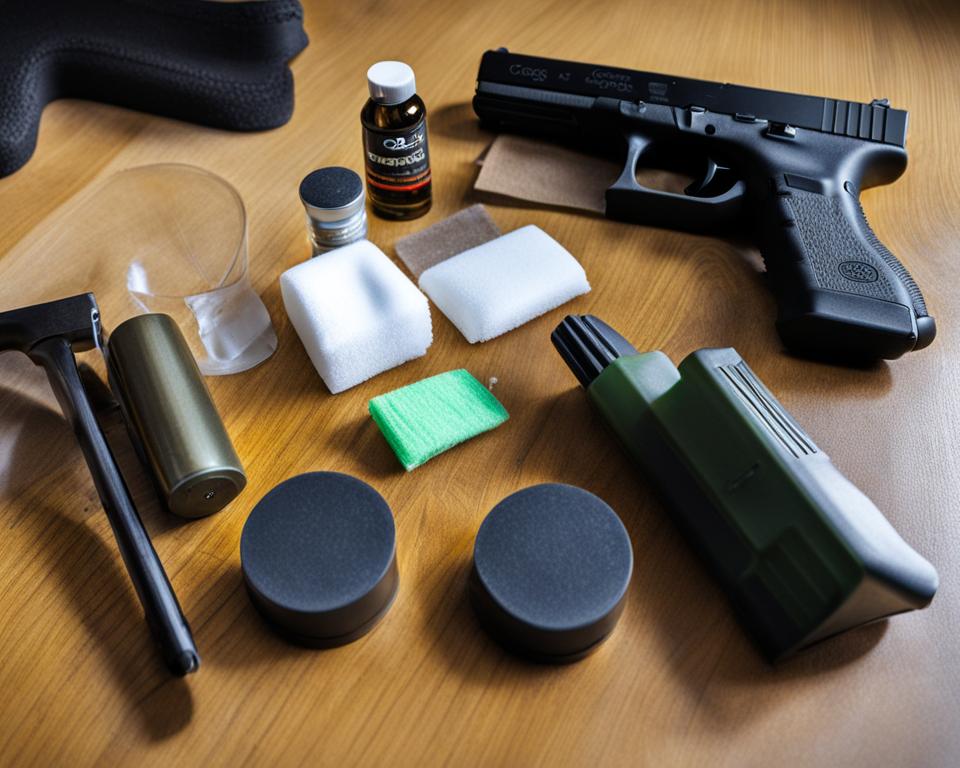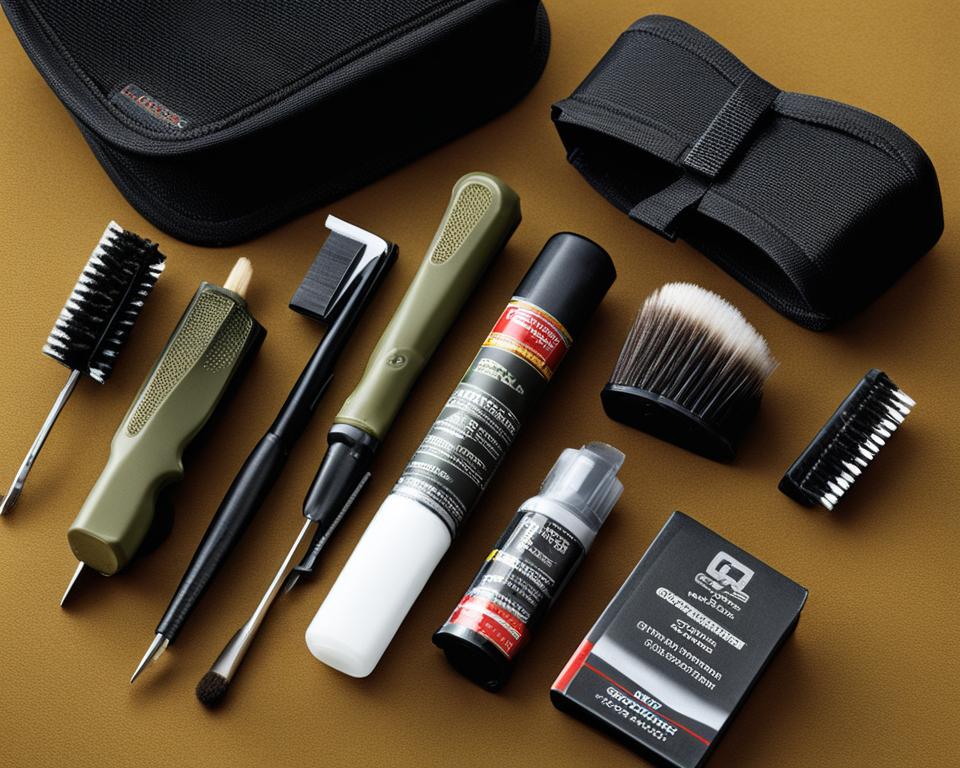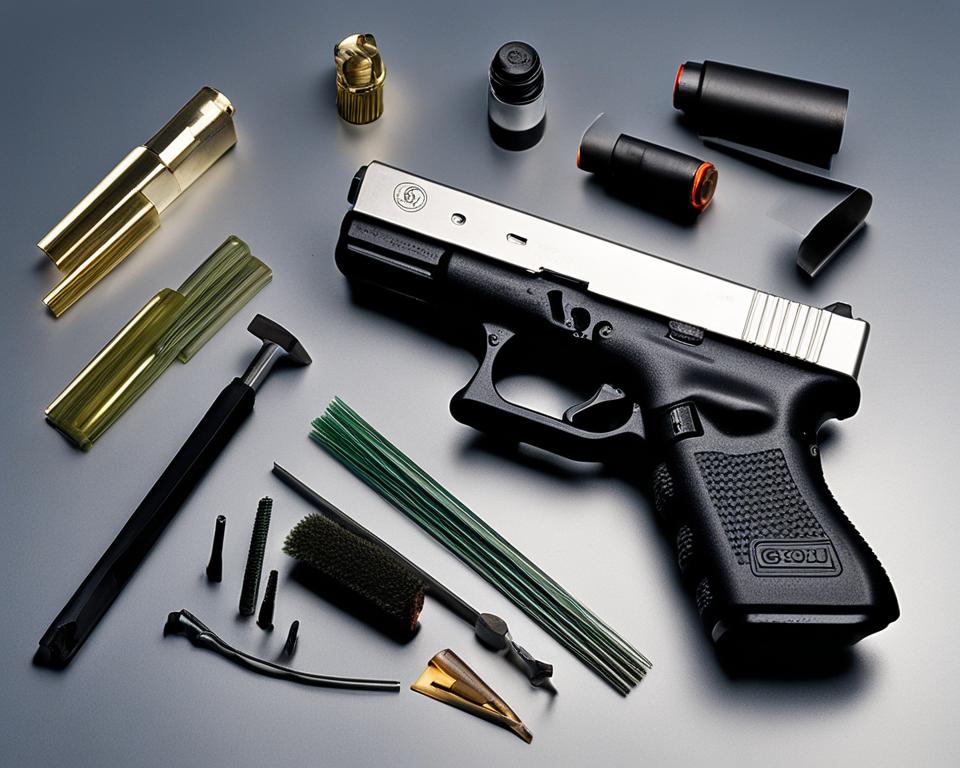Proper cleaning and maintenance are crucial for ensuring the reliability and performance of your Glock 30 and other similar striker-fired pistols. Neglecting to properly maintain your firearm can result in failures to fire or eject, compromising your safety and the effectiveness of your weapon. To ensure the longevity and optimal function of your Glock 30, it is important to follow the manufacturer’s recommendations for cleaning and maintenance.
Before cleaning your Glock 30, it is essential to read the owner’s manual and become familiar with the disassembly, cleaning, and reassembly procedures. Following the manufacturer’s guidelines will help prevent damage to the firearm and ensure that it continues to perform as intended. Additionally, it is important to observe safety precautions such as wearing goggles and gloves, maintaining proper ventilation, and cleaning up the work area to minimize any potential hazards.
Key Takeaways:
- Proper cleaning and maintenance are essential for the reliability and performance of your Glock 30.
- Read and follow the manufacturer’s recommendations for cleaning and maintenance.
- Adhere to safety precautions when cleaning your firearm.
- Familiarize yourself with the owner’s manual to ensure proper disassembly, cleaning, and reassembly.
- Failure to maintain your Glock 30 can result in malfunctions, compromising your safety and effectiveness.
Note: The provided image shows a Glock 30 firearm, which is relevant to the topic of this article.
Step-by-Step Guide for Cleaning Your Glock 30
To ensure the optimal performance and longevity of your Glock 30, regular cleaning and maintenance are crucial. Cleaning your Glock 30 not only helps remove dirt, debris, and fouling but also allows you to inspect and identify any potential issues. Follow these step-by-step instructions to properly clean your Glock 30:
- Field-strip your Glock 30: Begin by ensuring the firearm is unloaded and the magazine is removed. Follow the manufacturer’s instructions to field-strip the firearm.
- Clean the chamber and bore: Take a solvent-soaked patch and clean the chamber and bore of your Glock 30. Pay attention to the feed ramp and the interior of the barrel.
- Scrub the slide: Use a toothbrush dipped in solvent to scrub the interior surfaces of the slide. Focus on areas such as the breech face and slide rails to remove any built-up residue.
- Clean the frame: Clean the frame of your Glock 30, including the rails, trigger bar, ejector, and connector area. Use an appropriate cleaning solvent and a rag or brush.
- Wipe down the recoil spring assembly and magazines: Ensure the recoil spring assembly and the exterior of the magazines are clean. Use a clean cloth or rag to wipe them down.
- Scrub the slide rails: Pay special attention to the slide rails and clean them thoroughly. Remove any dirt or debris that may affect the smooth operation of the firearm.
- Inspect and reassemble: Once all the components are clean and dry, carefully inspect them for any signs of wear or damage. Reassemble your Glock 30 following the manufacturer’s instructions.
By following these proper Glock 30 cleaning techniques, you can ensure that your firearm remains in optimal condition. Regular cleaning is essential to maintain reliability and overall performance. Remember to always refer to your Glock 30 owner’s manual for detailed cleaning instructions.
Best Practices for Glock 30 Maintenance
In addition to regular cleaning, following some best practices is crucial for maintaining your Glock 30 in optimal condition. These practices ensure reliable feeding, prevent failures to feed and extract, and promote proper firearm function.
Clean the Feed Ramp
Thoroughly clean the feed ramp to remove carbon buildup and fouling from the chamber area. This promotes smooth and reliable feeding, reducing the risk of malfunctions during use.
Clean Behind the Extractor Hook
Pay attention to cleaning the area behind the extractor hook. This ensures proper extraction and prevents failures to feed and extract, improving the overall functioning of your Glock 30.
Periodically Disassemble the Slide
To ensure proper maintenance, it may be necessary to periodically disassemble the slide and clean the extractor thoroughly. This prevents malfunctions related to extractor issues and guarantees reliable ejection of spent casings.
Sparingly Apply Lubrication
When lubricating your Glock 30, apply oil sparingly to prevent excess oil buildup. Excess oil can attract dirt and create sticky residue, negatively impacting the firearm’s performance. Apply a light coating of oil to specific areas such as the barrel and slide rails for smooth operation.
By following these best practices, you can maintain the reliability and performance of your Glock 30 for years to come.

Popular Gun Cleaning Kits for Glock 30
When it comes to cleaning your Glock 30, having the right tools is essential. Investing in a high-quality gun cleaning kit can make the process much easier and more effective. Here are some popular options to consider:
| Brand | Features |
|---|---|
| Gloryfire | Affordable kit with various cleaning tools, including brushes, jags, and patches. Comes with a cleaning solution. |
| Otis | Compact and portable cleaning kit. It includes brushes, cleaning solutions, and specialized lens maintenance tools. |
| M-Pro 7 | Professional-grade kit with high-quality cleaning tools and non-toxic cleaning solutions. Suitable for regular firearm maintenance. |
| Allen Company | Affordable kit with a wide range of cleaning tools, including brushes, patches, and cleaning rods. Suitable for occasional cleaning. |
| Hoppes | Trusted brand with a comprehensive cleaning kit. It includes brushes, patches, and cleaning solutions for thorough maintenance. |
When choosing a gun cleaning kit for your Glock 30, consider factors like the availability of cleaning chemicals, compactness for easy storage and travel, and affordability. It’s also important to ensure that the kit covers the calibers and gauges relevant to your firearm to guarantee proper cleaning and maintenance.

Expert Tips for Glock 30 Cleaning
When it comes to cleaning your Glock 30, there are a few expert tips that can help you maintain its performance and longevity. First and foremost, always ensure that your firearm is unloaded and cleared of any ammunition before beginning the cleaning process. Safety should always be the top priority.
One effective technique is to use a dry brush to remove most of the dirt and fouling from the barrel before applying cleaning patches. This helps to loosen and dislodge debris, making it easier to clean the barrel thoroughly. Remember to clean the slide rails meticulously as they tend to collect dirt, which can affect the smooth operation of your Glock 30.
When it comes to lubrication, less is more. Apply a light coating of oil to the necessary areas, such as the barrel and slide rails. Excessive oil can attract dirt and residue, leading to potential malfunctions. By following these expert tips, you can ensure that your Glock 30 is properly cleaned and maintained, allowing for reliable and consistent performance.
FAQ
What are some cleaning tips for maintaining my Glock 30?
Proper cleaning and maintenance are crucial for the reliability and performance of your Glock 30. Follow the manufacturer’s recommendations for disassembling, cleaning, and reassembling your firearm. Ensure the firearm is unloaded and use a solvent-soaked patch to clean the chamber, bore, feed ramp, and interior of the barrel. Scrub the slide, frame, recoil spring assembly, and magazines. Wipe down all parts and ensure they are clean and dry before reassembling the firearm.
How should I clean my Glock 30 step-by-step?
To clean your Glock 30, start by field-stripping the firearm and ensuring it is unloaded. Clean the chamber, bore, feed ramp, and interior of the barrel using a solvent-soaked patch. Scrub the interior surfaces of the slide with a toothbrush and solvent, paying attention to the breech face and slide rails. Clean the frame, including the rails, trigger bar, ejector, and connector area. Wipe down the recoil spring assembly and exterior of the magazines. Finally, scrub the slide rails and ensure all parts are clean and dry before reassembling the firearm.
What are some best practices for Glock 30 maintenance?
In addition to regular cleaning, it is recommended to thoroughly clean the feed ramp to ensure reliable feeding and remove carbon and fouling from the chamber area. Clean the area behind the extractor hook to prevent failures to feed and extract. Periodically disassemble the slide to clean the extractor properly. Use lubrication sparingly, applying a light coating of oil on specific areas like the barrel and slide rails to prevent excess dirt buildup.
What are some popular gun cleaning kits for cleaning my Glock 30?
There are various gun cleaning kits available that are suitable for cleaning your Glock 30. Some popular brands include Gloryfire, Otis, M-Pro 7, Allen Company, and Hoppes. These kits typically come with a range of cleaning tools, such as brushes, jags, patches, and cleaning solutions. It is important to choose a kit that covers the calibers and gauges relevant to your firearm.
What are some expert tips for cleaning my Glock 30?
When cleaning your Glock 30, always ensure it is unloaded. Use a dry brush to push out most of the dirt and fouling from the barrel before applying cleaning patches. Thoroughly clean the slide rails, as they collect dirt and can affect the smooth operation of the firearm. Remember, less is more when it comes to lubrication. Apply a light coating of oil to necessary areas for proper function without attracting excess dirt.

Leave a Reply